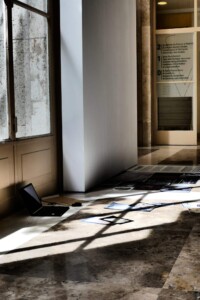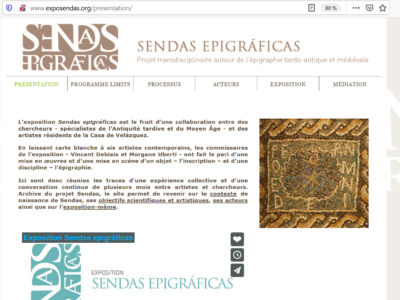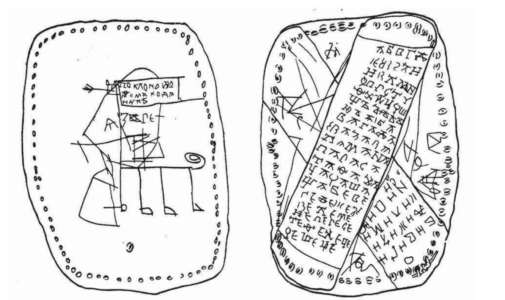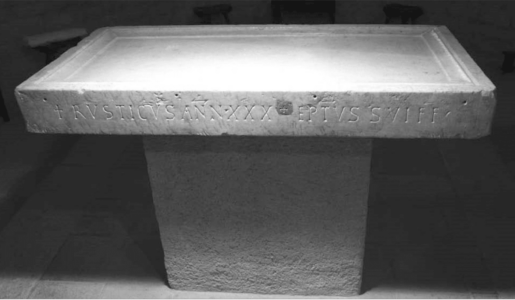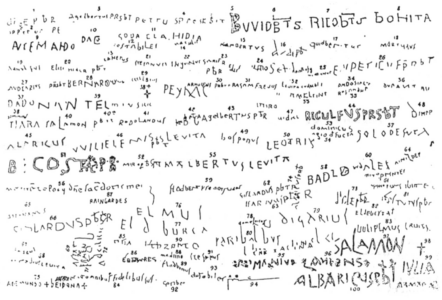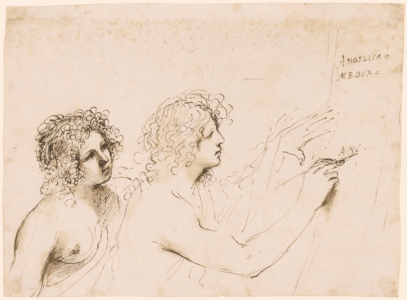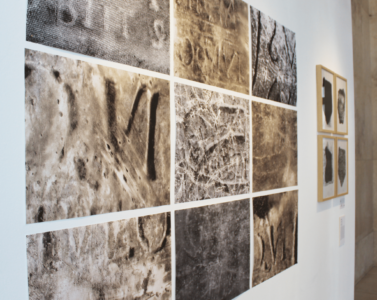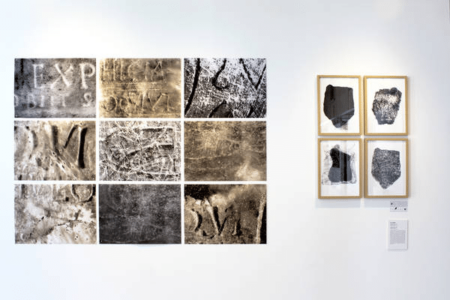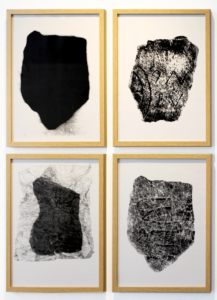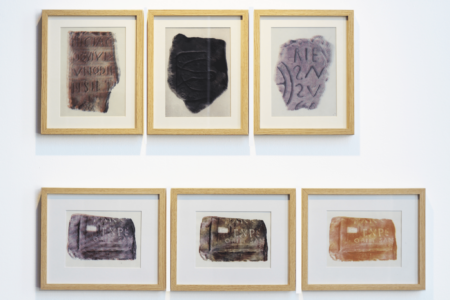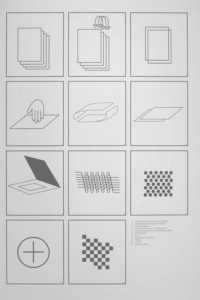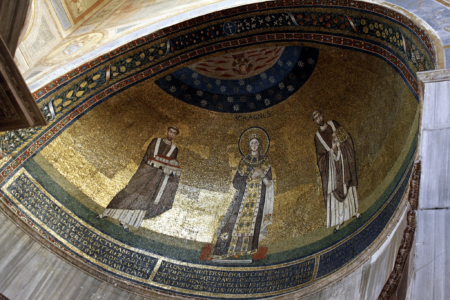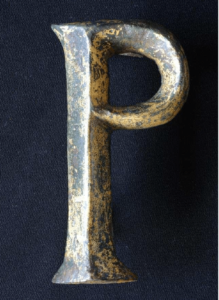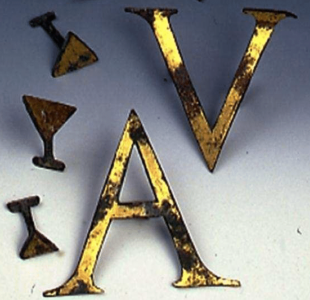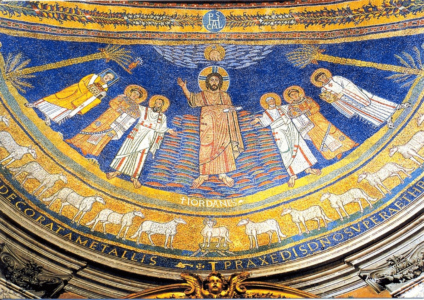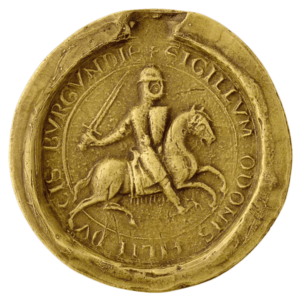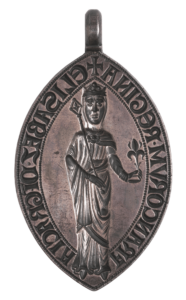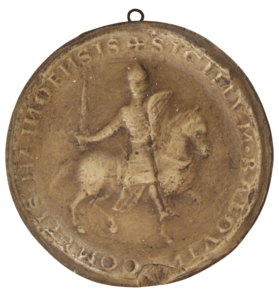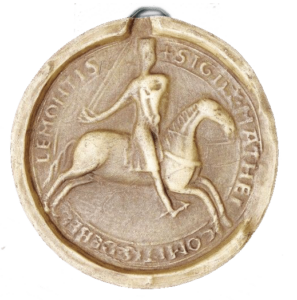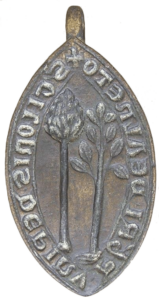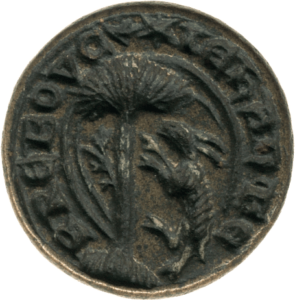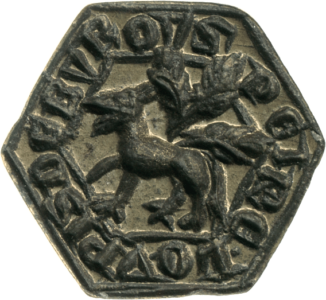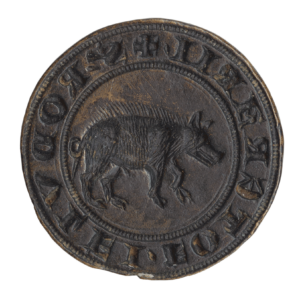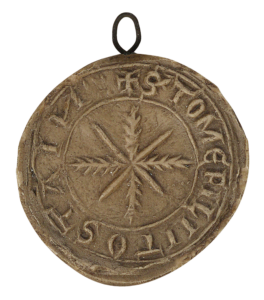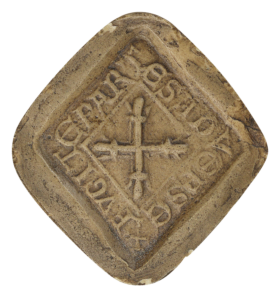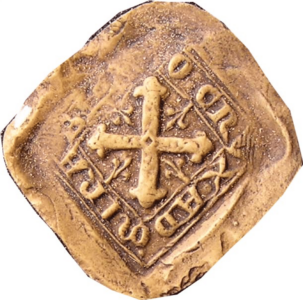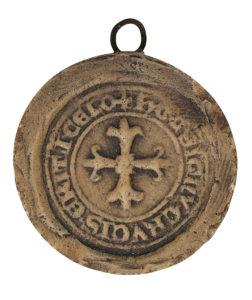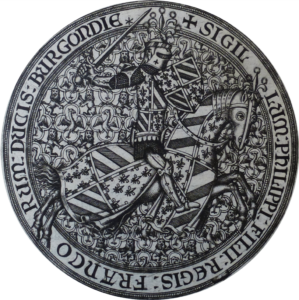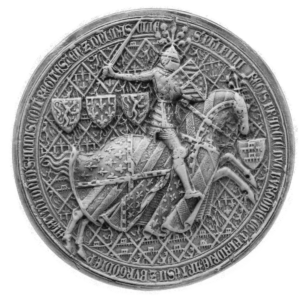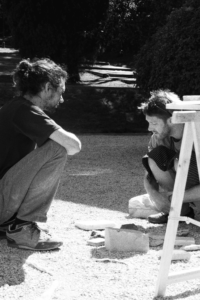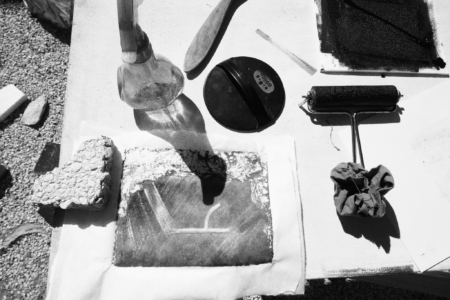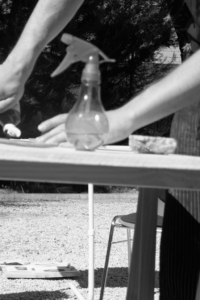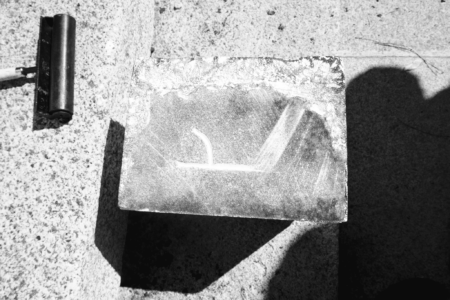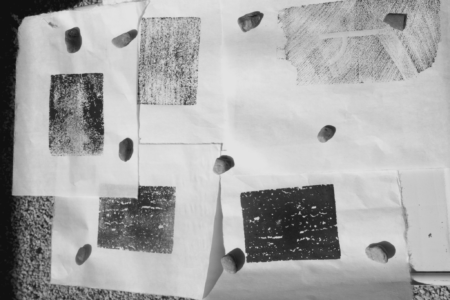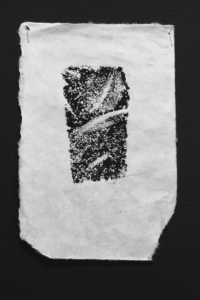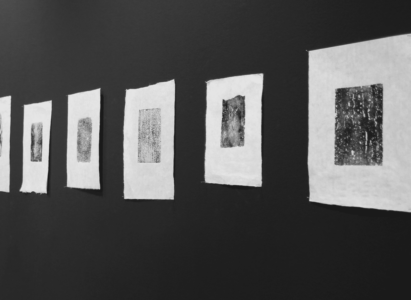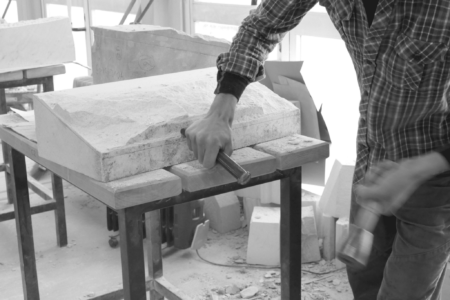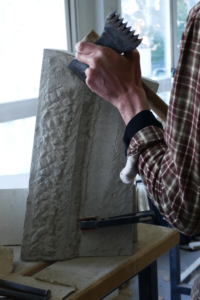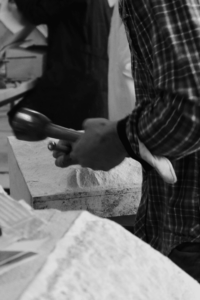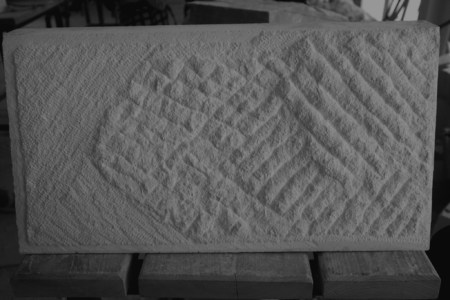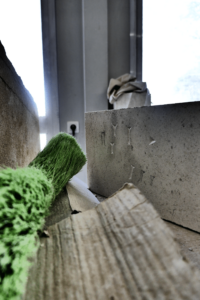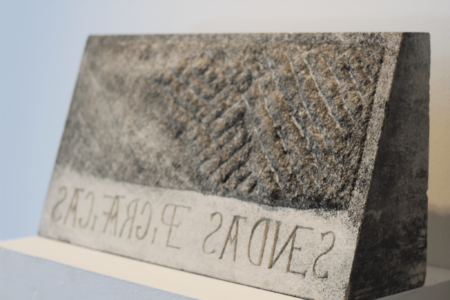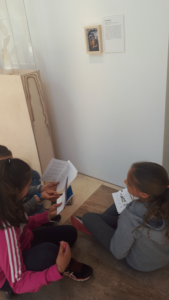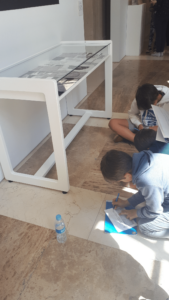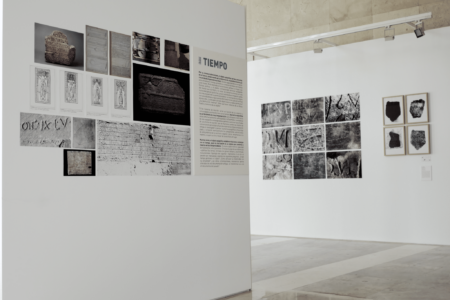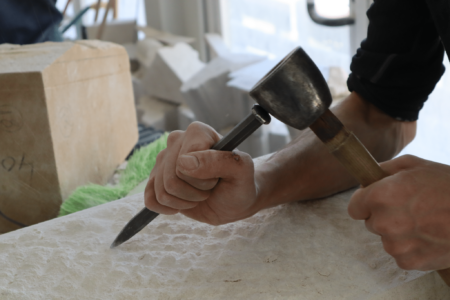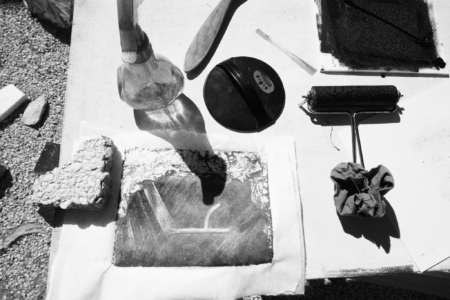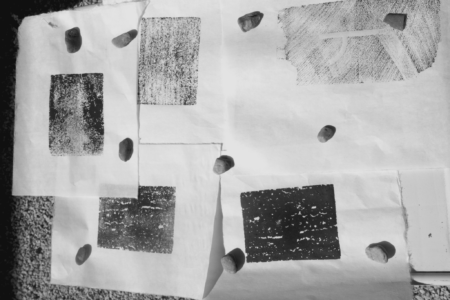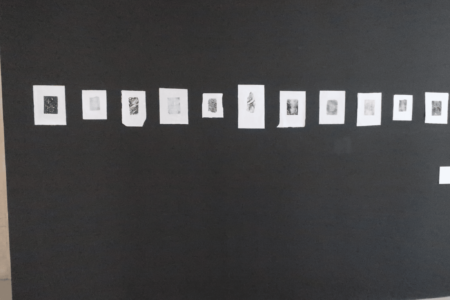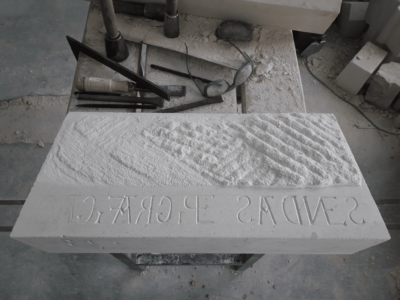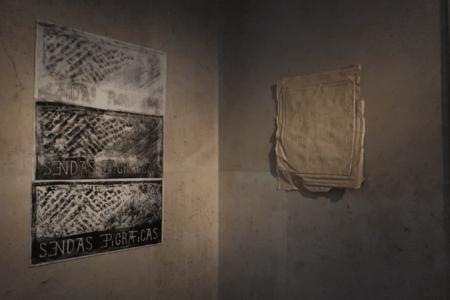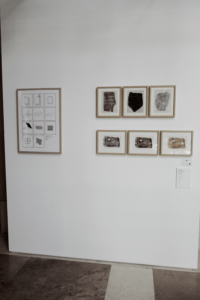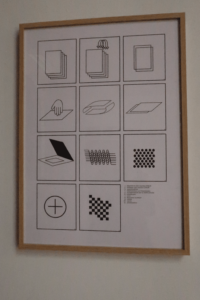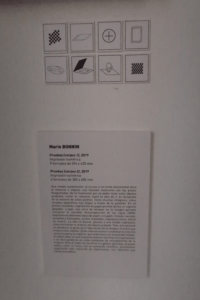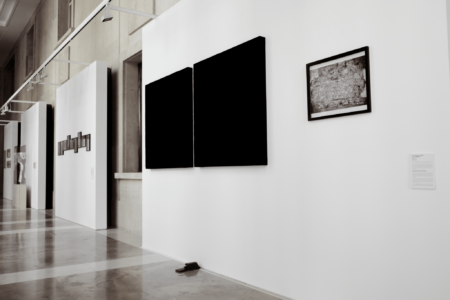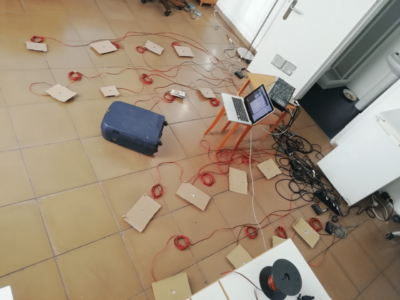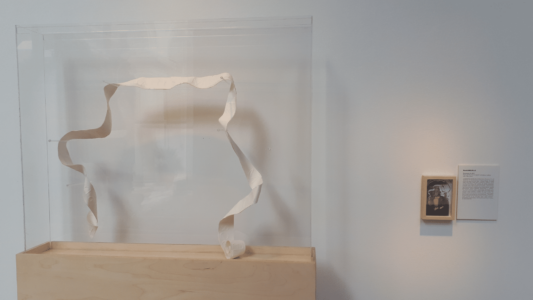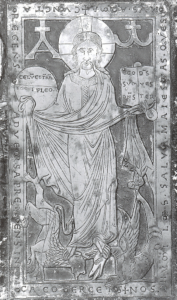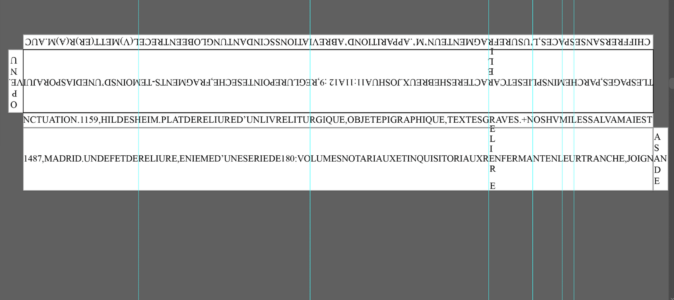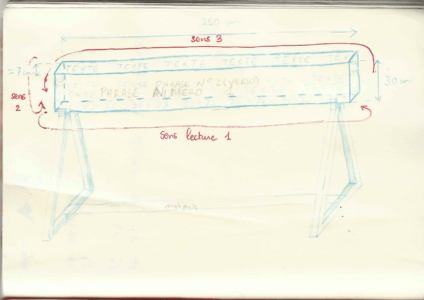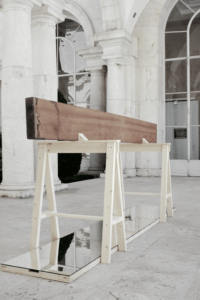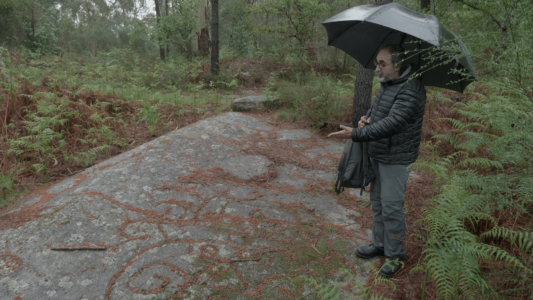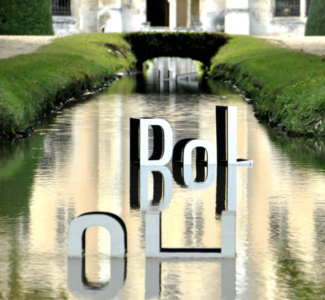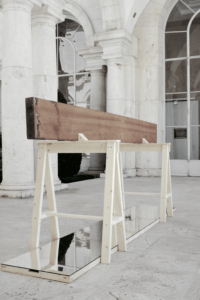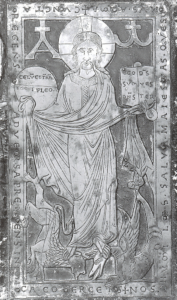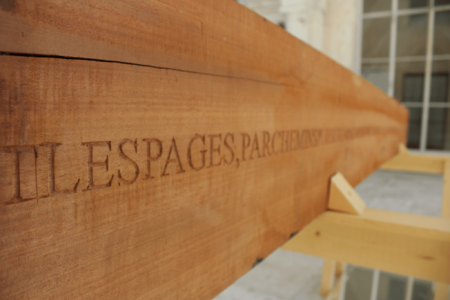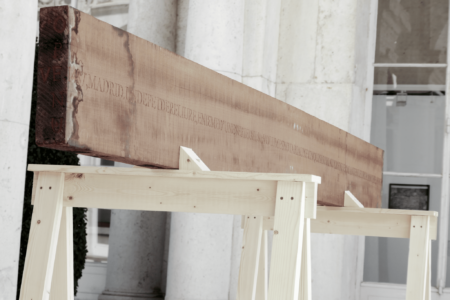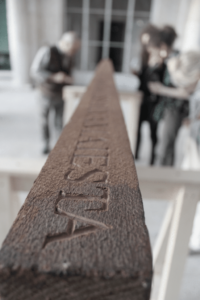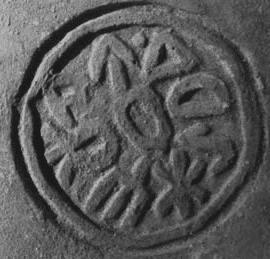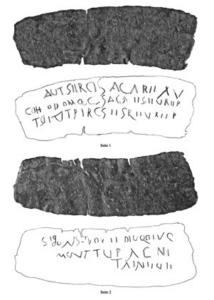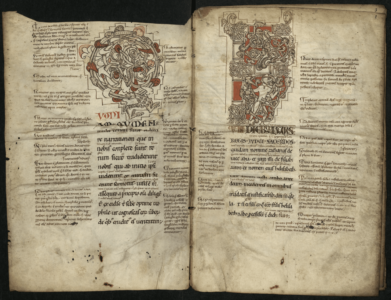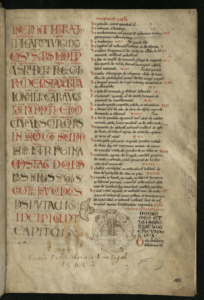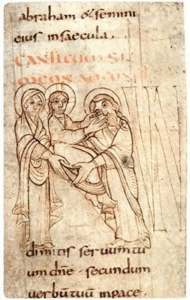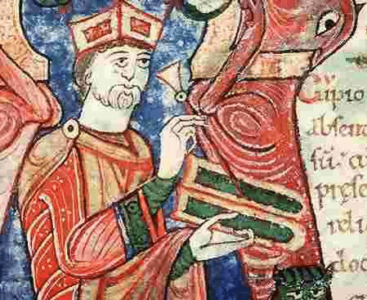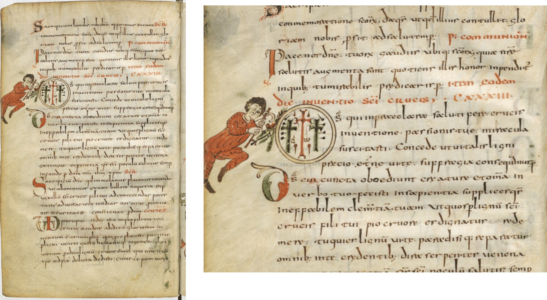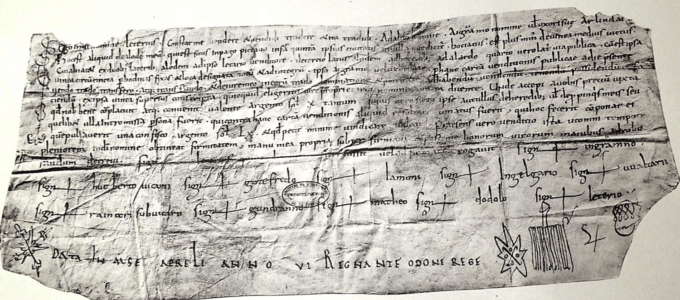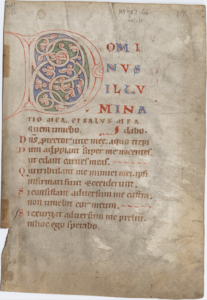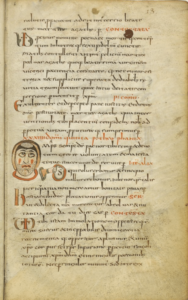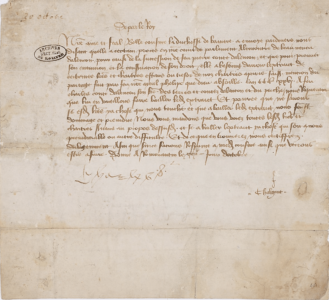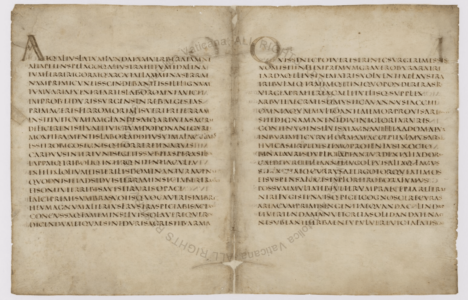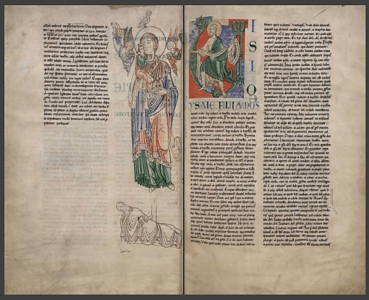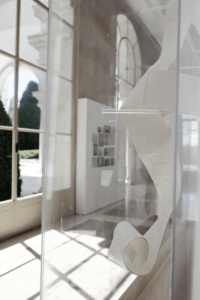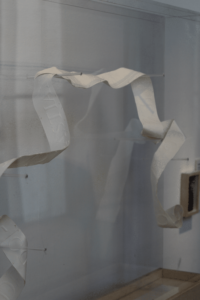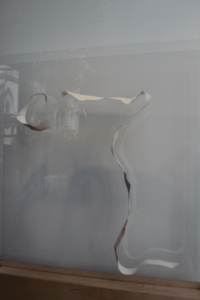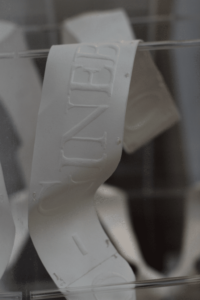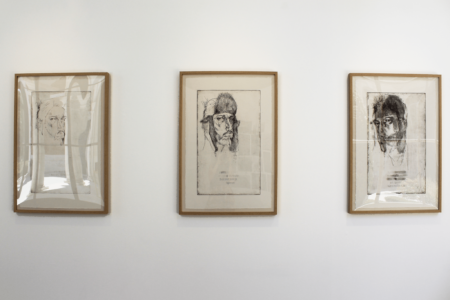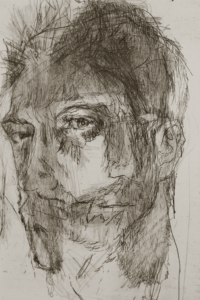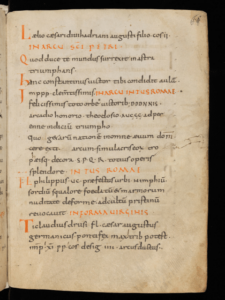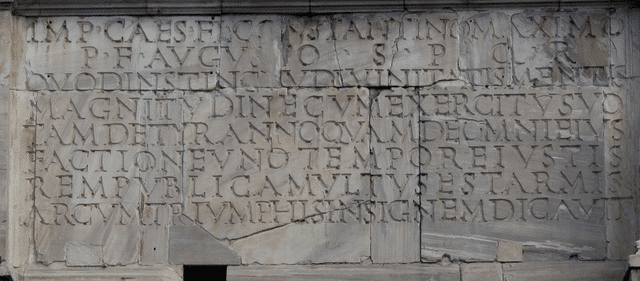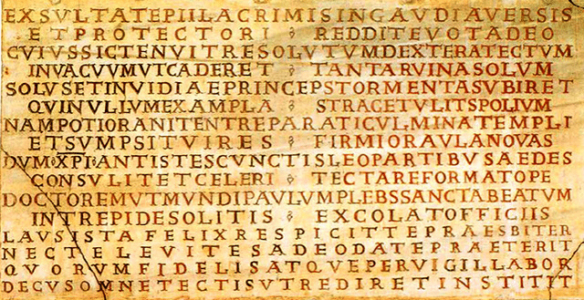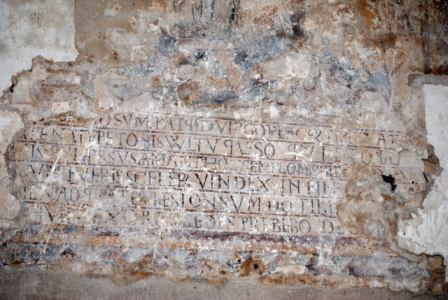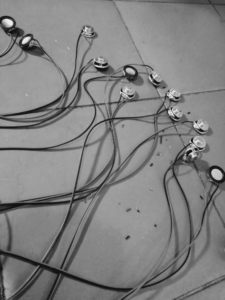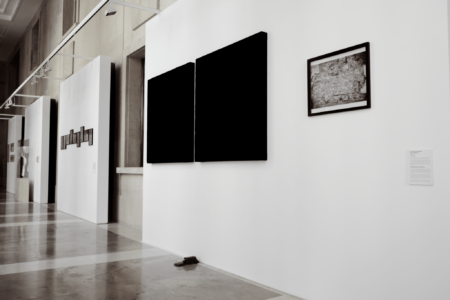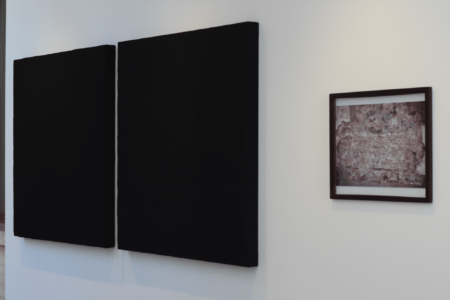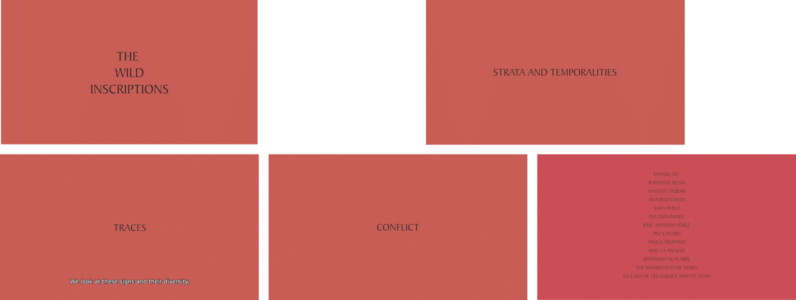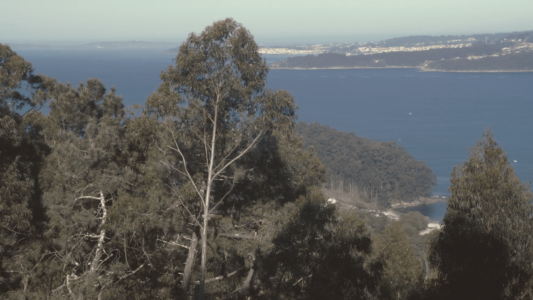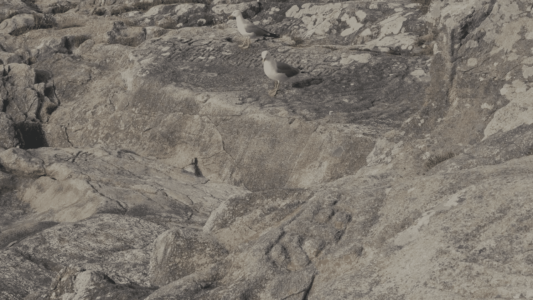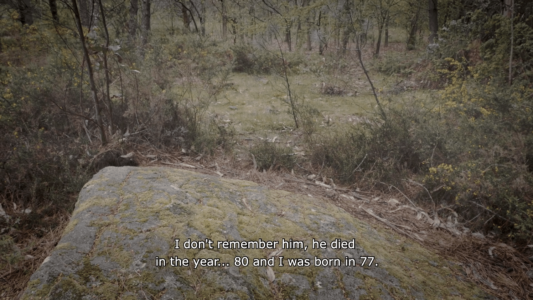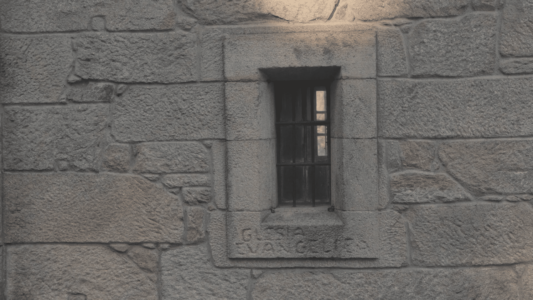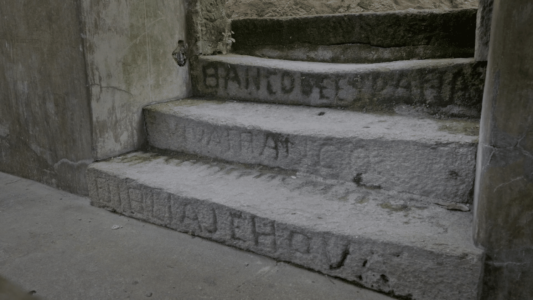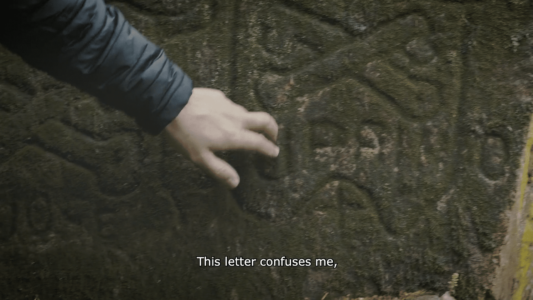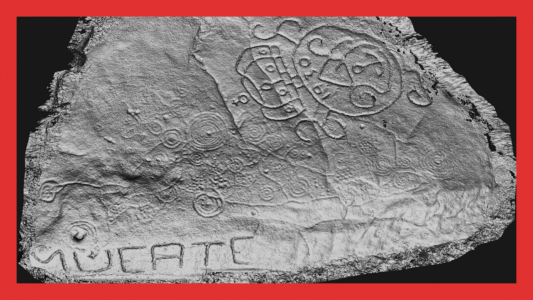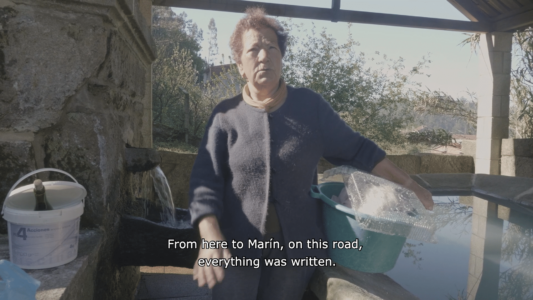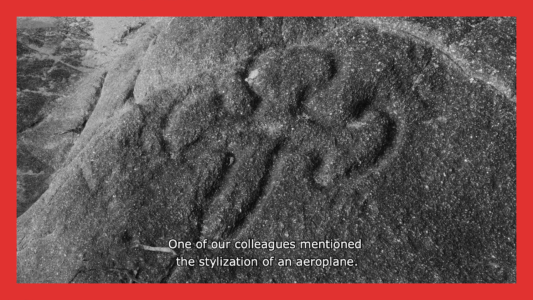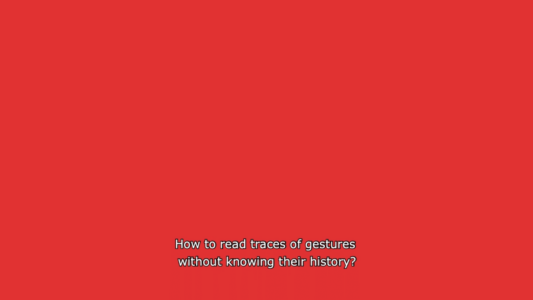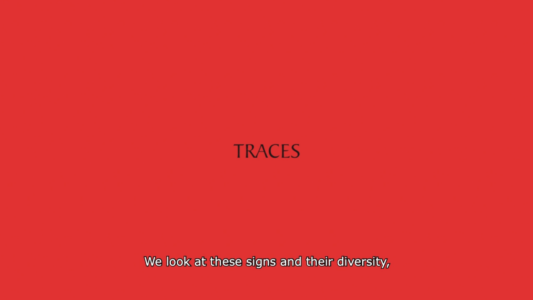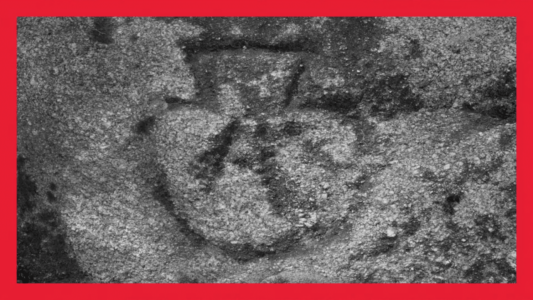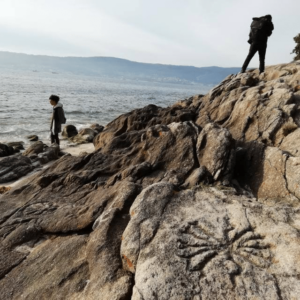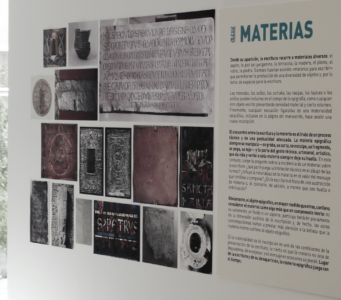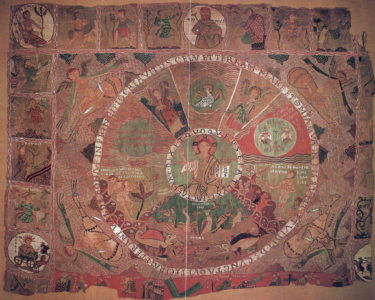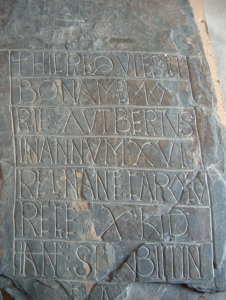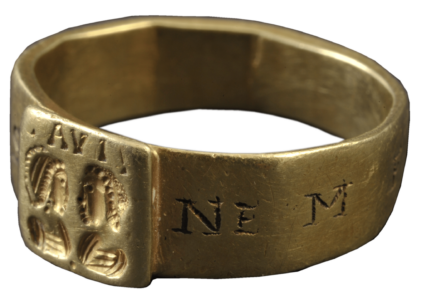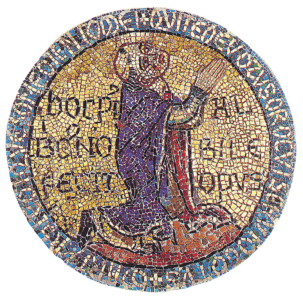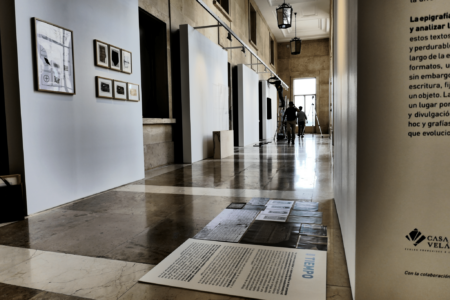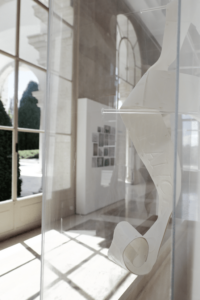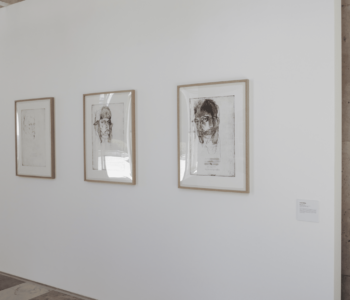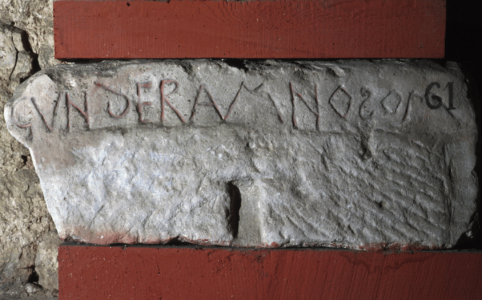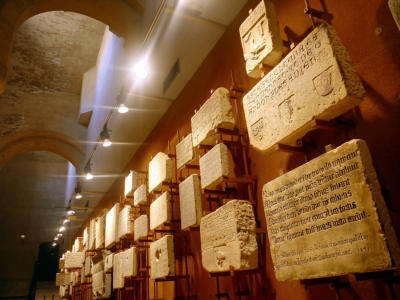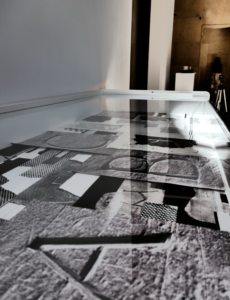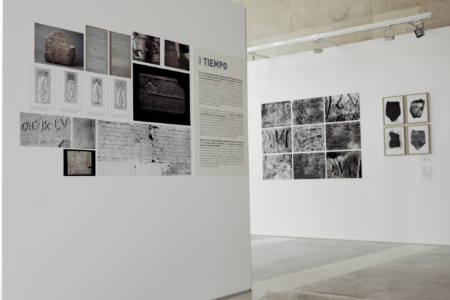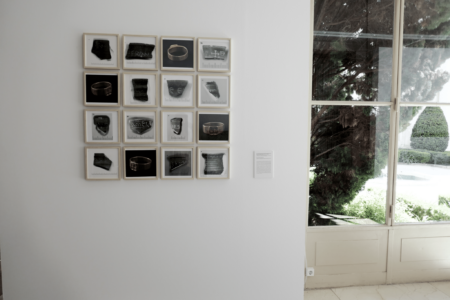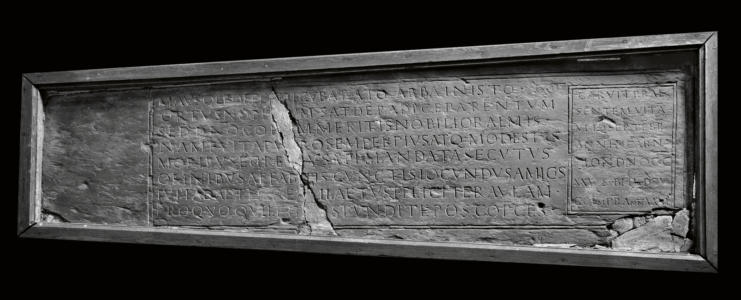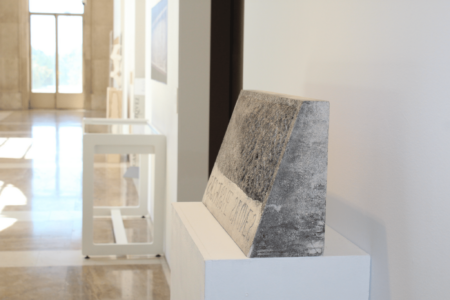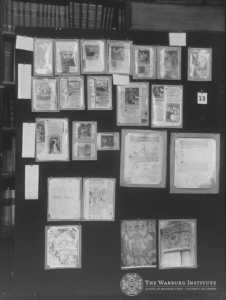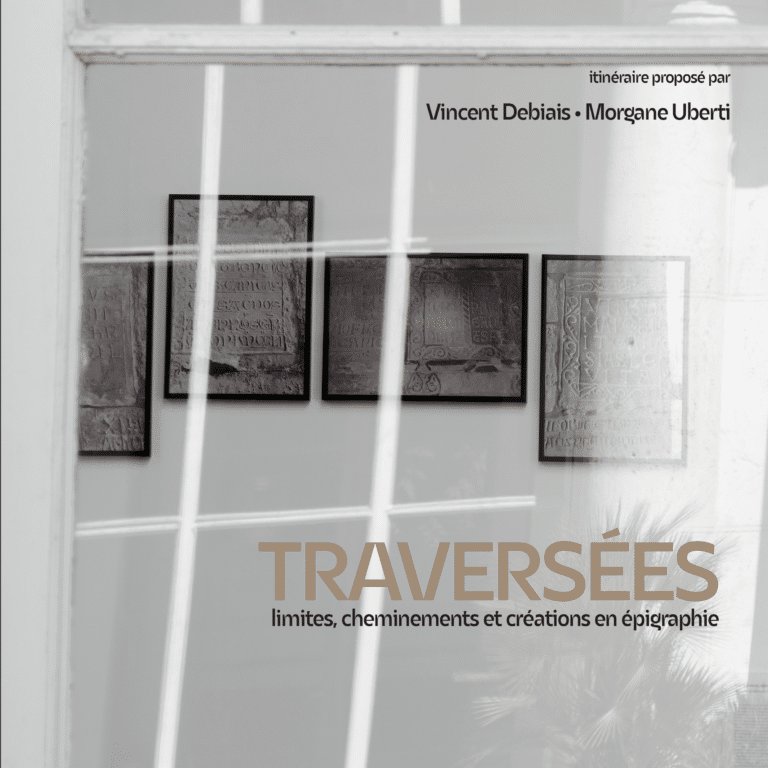OUVERTURE
TÉMOIGNAGES
PRATIQUES
EXPOSITION
TRAVERSES
ATLAS
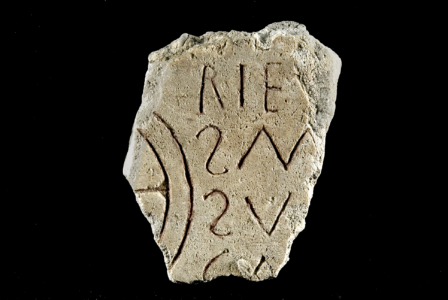
Inscription tardo-antique découverte à Lyon comptant parmi les sources d’inspiration de Marie Bonnin © Musée Ludgunum-Grand Lyon.
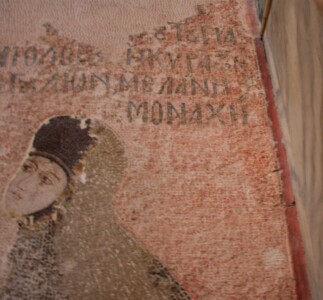
Constantinople, Saint-Sauveur-in Chora, XIVe siècle, mosaïque du narthex, détail du mortier de pose avec tracé préparatoire de l’inscription, peint en noir sur fond rouge © E. Neri.
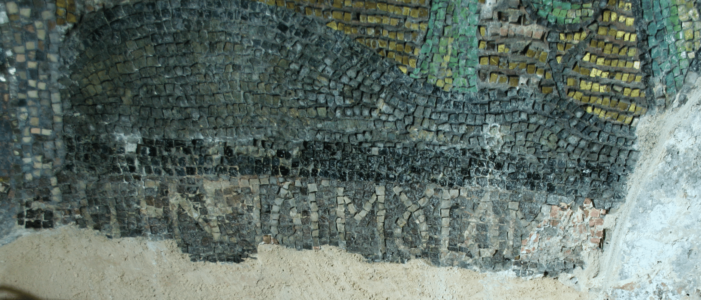
Mar Gabriel, paroi est de la chapelle, inscription en mosaïque (lettre en tesselles en pierre blanche sur fond des tesselles blues grises en verre), VIe siècle.
(a) Détail de la peinture préparatoire rouge sans tracé peint des lettres (b) © E. Neri.
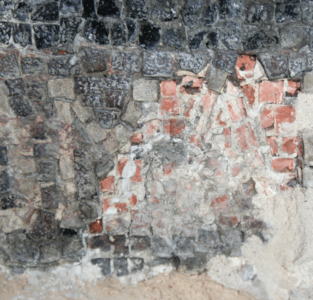
Mar Gabriel, paroi est de la chapelle, inscription en mosaïque (lettre en tesselles en pierre blanche sur fond des tesselles blues grises en verre), VIe siècle.
(a) Détail de la peinture préparatoire rouge sans tracé peint des lettres (b) © E. Neri.
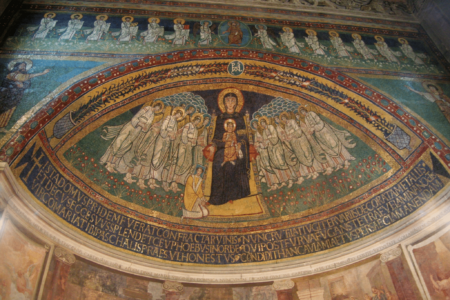
Inscriptions entre tabula dans les mosaïques absidale de Rome : b) Sainte-Maria-in Dominica, VIIe siècle, inscription encadrée par une tabula ansata (© G. Sosio).
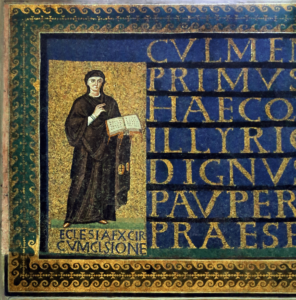
Rome, Sainte-Sabine, inscription de la contre façade, Ve siècle. Tesselles en verre à feuille d’or sur fond de tesselles blues en verre © E. Neri.
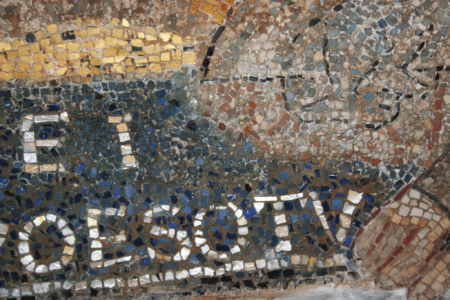
Germigny dès Près, oratoire de Théodulf, détail de l’inscription de la mosaïque du cul-de-four. Lettres en tesselles à feuille d’argent dans un fond des tesselles bleues foncées et claires © E. Neri.
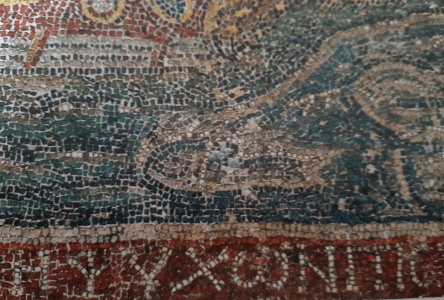
Thessalonique, Hosios-David, détail de l’inscription de la mosaïque du cul-de-four. Lettre en tesselles à feuille d’or et argent sur un fond rouge (de Mosaics of Thessaloniki, 2012).
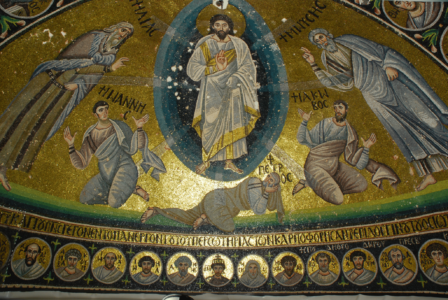
Monastère de Sainte Catherine du Sinai, mosaïque du cul-de-four avec lettres noires sur fond or © E. Neri.
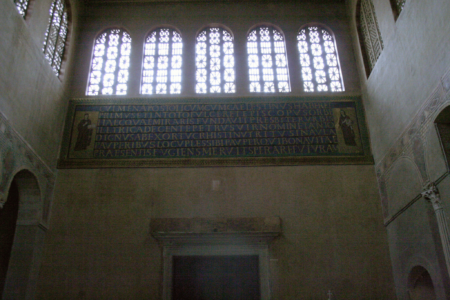
Rome, Sainte Sabine, inscription de la contre façade, Ve siècle, observée à la lumière naturelle à midi en janvier © E. Neri.
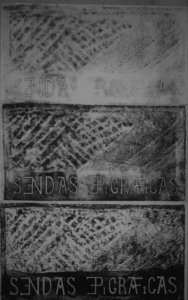
Encrage et impressions de pierre (Papel coreano Hanji 40/45 gramme, (70 x 37 gr.), galerie de la Casa de Velázquez © CVZ.

Fragments de l’Ancien Testament, copié au XVe siècle, retrouvé caché dans une reliure de livre profane d’origine madrilène.
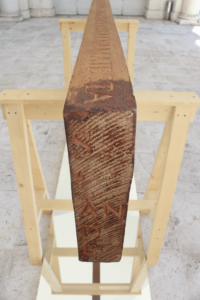
Relire-Relier, détail, inscription sur la tranche relative au texte inscrit sur le plat de reliure médiéval © CVZ.
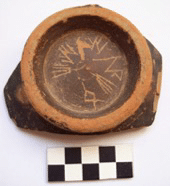
Graffite sur fond de céramique campanienne A (Ensérune, BdHesp HER.02.068) Datation : IIe s. a.C. © C. Ruiz Darasse.
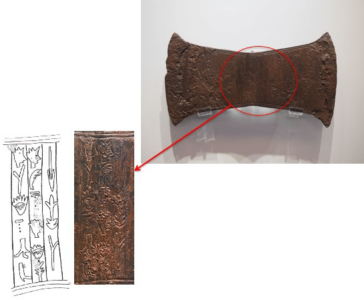
Double hache votive minoenne avec inscription en Linéaire A (?) trouvée dans la grotte d’Arkalochori (Crète) en 1934. Datation : IIe millénaire a.C. (autour de 1500 a.C. ?) © WikiCommons.
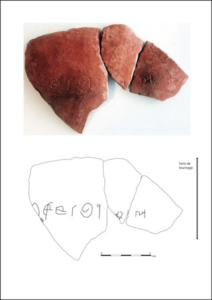
Fragment de céramique tournée trouvée à Bram-Buzerens (Aude) en 2015 ; Fouilles Archeodunum (© Archéodunum, A. Lemaire) ; Datation : Haut-Empire.
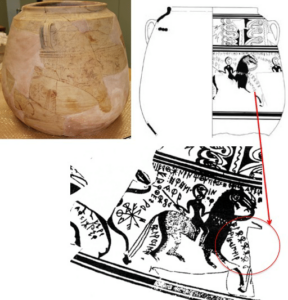
Vase des Guerriers avec décors et inscriptions peints (Sant Miquel de Llíria, Valence) MLH III, F.13.3.
Photo : BdHesp, ALF ; Dessin : SIP. Datation : 210-180 a.C.

Pseudo-inscriptions peintes sur un cratère de Carlsruhe B 32 (dessin C. Jubier Galiner d’après CVA Carlsruhe 1, pl. 9.2).
Source : Jubier Galinier 1998, fig. 1.
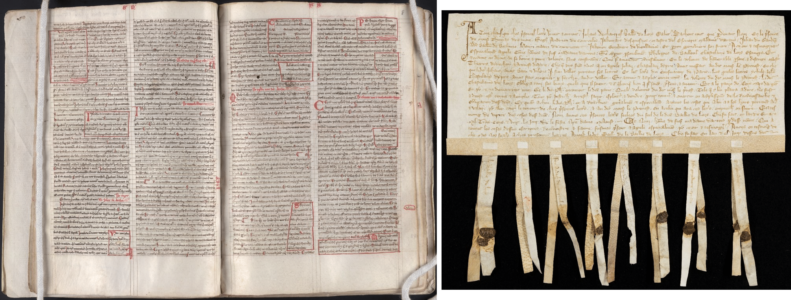
À gauche : Pierre Le Mangeur, Historia Scholastica, ca. 1225-1300, Yale, Beinecke Ms. 520, fol. 7v-8r ; à droite : Lettre du châtelain de Lens, notifiée par le bailli de Lens, 15 août 1308, AD Pas-de-Calais, A 54/15. Photo AD Pas-de-Calais.
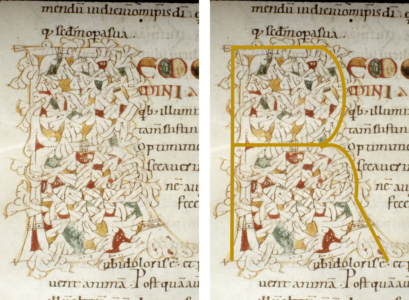
À gauche : Lettre R. Haimo, In epistolas S. Pauli, 1067. Oxford, Bodleian Ms. Add. D. 104, fol. 179v ; à droite : même lettre avec tracé moderne du R.
![Chirographe de Baudry, évêque de Noyon-Tournai en faveur de l’abbé d’Anchin, 1101. Lille, Archives départementales du Nord [AD], 1H 34/384.](https://una-editions.fr/wp-content/uploads/cache/2023/12/B@lades3_BedosRezak_fig8/3657249548.png)
Chirographe de Baudry, évêque de Noyon-Tournai en faveur de l’abbé d’Anchin, 1101. Lille, Archives départementales du Nord [AD], 1H 34/384.

Livre de modèles d’initiales, peut-être aussi cahier d’exercice. Toscanie, ca. 1175, Cambridge, Fitzwilliam, Ms. 83-1972.
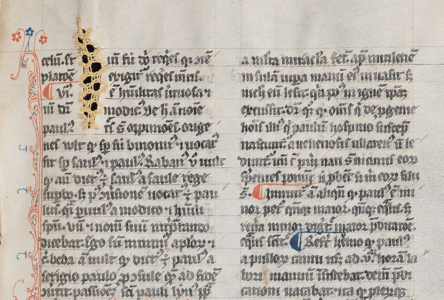
Jacques de Voragine, Légende dorée, XIVe siècle. Bibliothèque cantonale et universitaire de Fribourg, Suisse. Ms. L 34 166r.
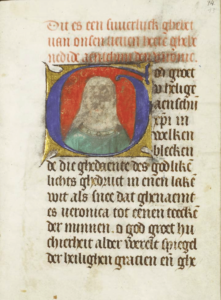
Lettrine contenant le Christ en buste, introduisant une prière à la Face du Christ. Cette face est totalement décolorée par les contacts dont elle fut l’objet. Bruxelles, KB, Ms. IV 414, fol. 13r. D’après Kathryn M. Rudy, “Kissing Images, Unfurling Rolls, Measuring Wounds, Sewing Badges and Carrying Talismans: Considering Some Harley Manuscripts through the Physical Rituals They Reveal”, The Electronic British Library Journal, 2012.
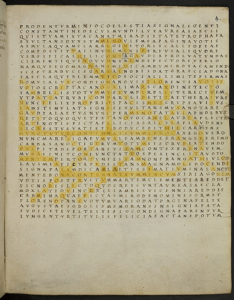
Optatianus Porfyrus, poème 19, tel qu’il est présenté au XVIe siècle, Codex Augustaneus 9 Guelferbytanus, fol. 4r. Herzog August Bibliothek, Wolfenbüttel.
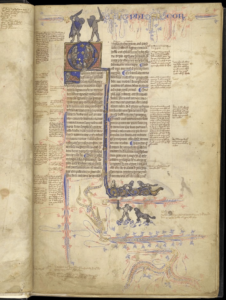
Aristotle, Libri Naturales, abondamment glosé, XIIIe siècle. London, British Library, Harley Ms. 3487.
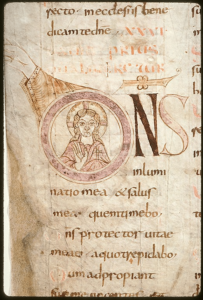
Initiale D, avec Christ en majesté. Psautier de Corbie. France, début du IXe siècle. BM Amiens métropole, Ms. 18, fol. 22v.
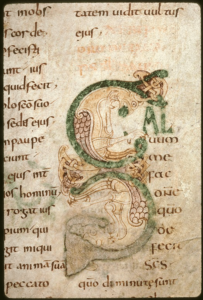
Initiale S, avec hybride anthropomorphe, se débattant contre la lettre qui l’emprisonne et le fait passer de l’état humain à l’état bestial. Psautier de Corbie. France, début du IXe siècle. BM Amiens métropole, Ms. 18, fol. 10.
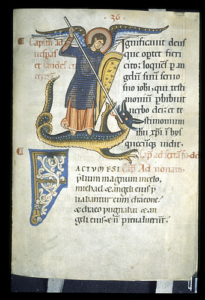
Initiales S et F ; le S est avant tout la figure de St Michel combattant le dragon. Ottobeuren Collectar, Ottobeuren, Germany, 1175-1200. British Library, Yates Thompson 2 Collectar, fol. 37r.
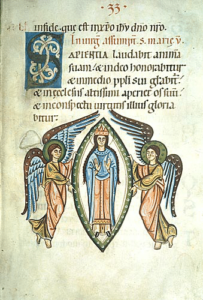
Initiale S ; la lettre appartient non au titre, In virg(inis) assumpti(oni) s(anctae) Mariae v(irginis), lequel est figuré, mais au terme sapientia, par lequel débute le texte tiré de l’Ecclésiaste, chap. 24. Ottobeuren Collectar, Ottobeuren, Germany, 1175-1200. British Library, Yates Thompson 2 Collectar, fol. 34.
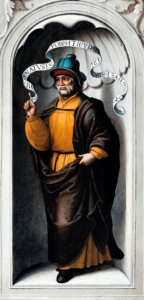
El profeta Isaías, Juan Correa de Vivar, huile sur toile (90 x 43.5 cm), Museo del Prado © Wikipedia.
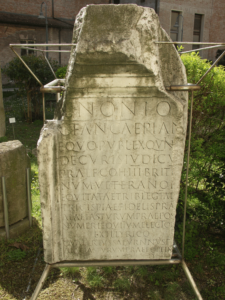
Statue base from Ariminum (Rimini) ; CIL XI 393 = ILS 2739; Date: Around AD 120/30; Present Location: Museo della Città, Rimini (Lapidario); © C. Witschel.
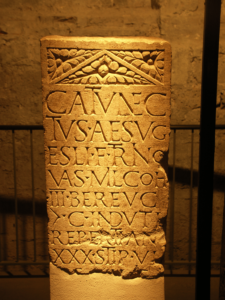
Funerary inscription of a soldier named Catunecus, son of Aesugeslus, from the Oppidum Ubiorum (Cologne) ; AE 2003, 1218; Date: Early 1st c. AD; Present Location: Römisch-Germanisches Museum Köln (Praetorium); © C. Witschel.
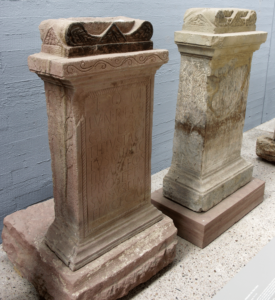
Two altars with votive inscriptions from the sanctuary of the beneficiarii consularis at Osterburken. AE 1985, 693 (left) and AE 1985, 696 (right); Date: AD 174 and second half of 2nd c. AD; Present Location: Römermuseum Osterburken; © C. Witschel.
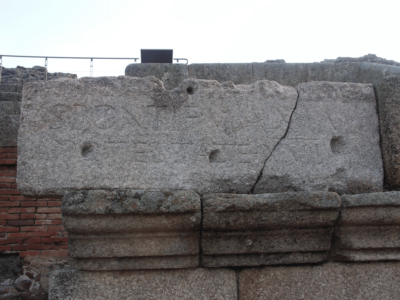
Fragment of a building inscription in the amphitheatre of Emerita Augusta (Mérida), naming the Emperor Augustus as donor of the building.
Cat. Inscr. Imper. Aug. Emerita 10; Date: 8/7 BC; © C. Witschel.
Cat. Inscr. Imper. Aug. Emerita 10; Date: 8/7 BC; © C. Witschel.
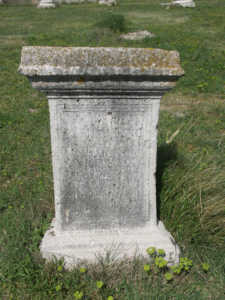
Statue base with an honorific inscription for Marcus Minatius Sucessus, standing on the forum of the Roman town of Herdonia (Ordona). AE 1967, 97; Date: Early 3rd c. AD; © C. Witschel.
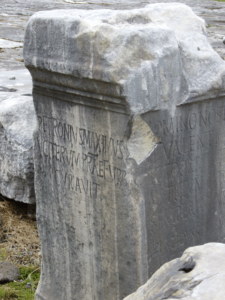
Statue base on the Forum Romanum in Rome; first erected for Emperor Valens in AD 364/65, later reused by the praefectus urbi Petronius Maximus between AD 421 and 439. CIL VI 36956 = ILS 8948; © C. Witschel.
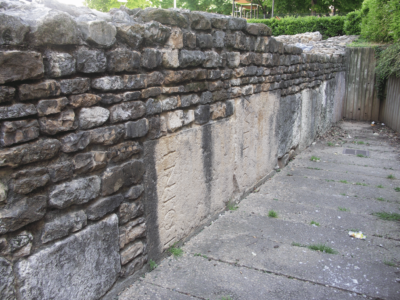
Late antique wall in Lugdunum (Lyon) containing earlier inscriptions
as building material. © C. Witschel.
as building material. © C. Witschel.
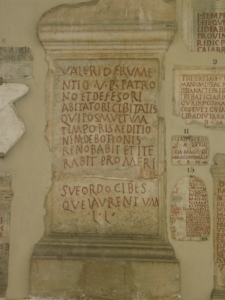
Statue base (front side) with an honorific inscription for Valerius Frumentius, vir perfectissimus, from Lavinium. CIL XIV 2080 = ILS 6186; Date: 4th c. AD; Present Location: Città del Vaticano, Musei Vaticani (Galleria Lapidaria); © C. Witschel.
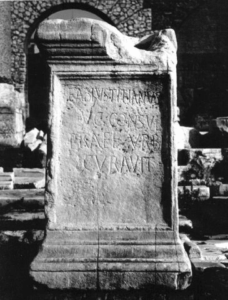
Statue base (reused), erected by the praefectus urbi Fabius Titianus in front of the Basilica Aemilia on the Forum Romanum in Rome. CIL VI 37107; Date: AD 339–341; © DAI Rome.
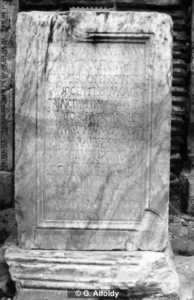
Statue base with an honorific inscription for the local magistrate Titus Flavius Vibianus, found in the eastern portico of the Forum Severianum in Lepcis magna. IRT 567; Date: 4th c. AD; © G. Alföldy.
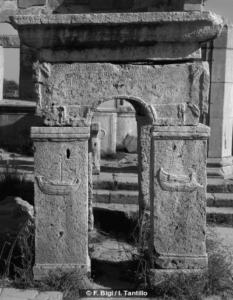
Small tetrapylon exhibiting an honorific inscription for a local benefactor called Porfyrius, standing on the “Punic Market” in Lepcis magna. IRT 603; Date: Late 3rd/early 4th c. AD; © F. Bigi / I. Tantillo.
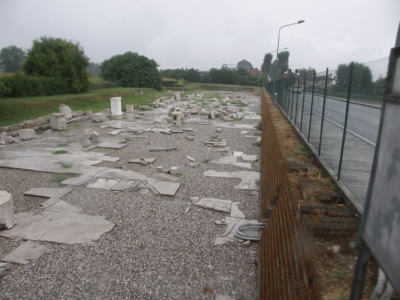
View of the western part of the forum at Aquileia which has recently been excavated. Some late antique inscriptions were found here. © C. Witschel.
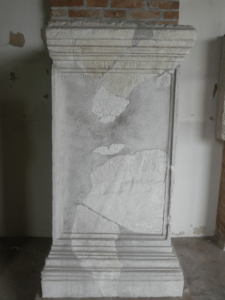
Base (reused) for the statue of a god (Hercules?), re-erected by the governor (corrector Venetiae et Histriae) Septimius Theodulus on the western side of the forum of Aquileia in order to adorn the place (ornavit). AE 1996, 686a-b; Date: AD 350/60; Present Location: Museo Archeologico Nazionale, Aquileia; © C. Witschel.
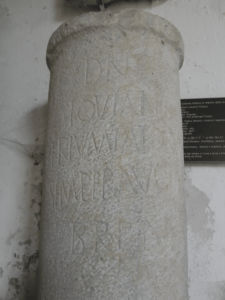
Milestone with an (honorific) inscription for Emperor Iovian (later re-inscribed for Emperors Valentinian I., Valens and Gratian), found besides a Roman road in the vicinity of Aquileia. Inscr. Aquil. II 2895; Date: AD 363/64; Present Location: Museo Archeologico Nazionale, Aquileia; © C. Witschel.
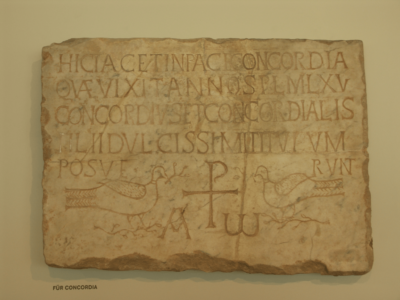
Funerary inscription (back side; reworked for reuse) of a woman called Concordia, decorated with Christian symbols. Found in the southern necropolis around St. Matthias at Treveri (Trier). CIL XIII 3810 = RICG I 13; Date: 5th c. AD; Present Location: Rheinisches Landesmuseum Trier; © C. Witschel.
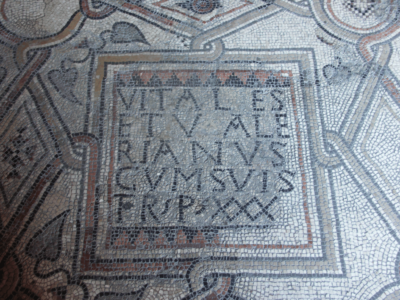
Christian votive inscription on the mosaic floor of the Basilica S. Eufemia in Grado, stating the number of pedes which had been donated by Vitales and Valerianus.
CIL V 1612 = Inscr. Aquil. III 3358; Date: Around AD 580; © C. Witschel.
CIL V 1612 = Inscr. Aquil. III 3358; Date: Around AD 580; © C. Witschel.
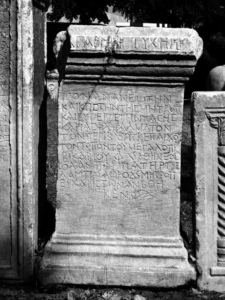
Statue base (reused) and statue of Flavius Palmatus, governor of the province of Caria, found in a rectangular square (tetrastoon) behind the theatre of Aphrodisias. ALA 62;
Date: Late 5th/early 6th c. AD; © ALA and C. Witschel.
Date: Late 5th/early 6th c. AD; © ALA and C. Witschel.
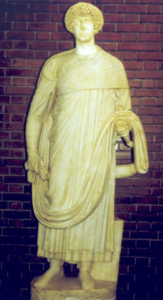
Statue base (reused) and statue of Flavius Palmatus, governor of the province of Caria, found in a rectangular square (tetrastoon) behind the theatre of Aphrodisias. ALA 62;
Date: Late 5th/early 6th c. AD; © ALA and C. Witschel.
Date: Late 5th/early 6th c. AD; © ALA and C. Witschel.
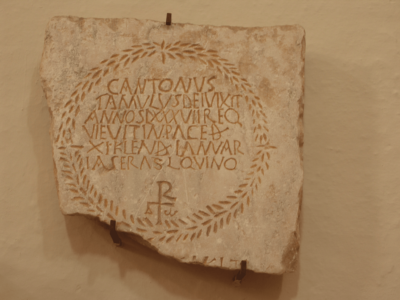
Funerary inscription of Cantonus, famulus Dei, from Emerita Augusta (Mérida). Cat. Inscr. Crist. Mérida 27; Date: AD 517; Present Location: Museo Visigotico, Mérida;
© C. Witschel.
© C. Witschel.
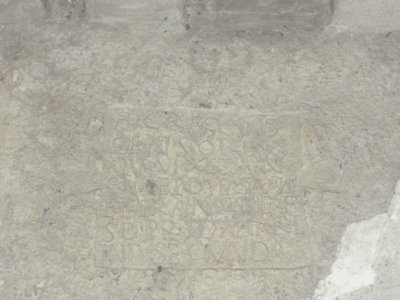
Funerary inscription of Censorius, vir spectabilis, found within the floor of the late antique church beneath S. Vigilio at Tridentum (Trento). AE 1990, 426; Date: Probably mid-6th c. AD; © C. Witschel.
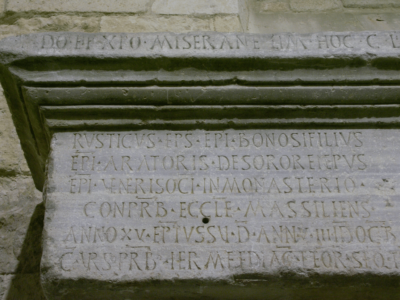
Door lintel with an inscription commemorating the construction of a church under the leadership of bishop Rusticus of Narbo (Narbonne). CIL XII 5336 = ILCV 1806; Date: AD 445; Present Location: Musée archéologique de Narbonne; © C. Witschel.
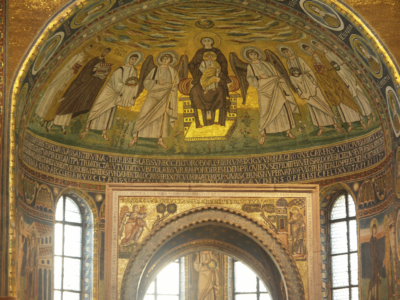
Building inscription on a mosaic in the apse of the basilica constructed and decorated under the guidance of bishop Eufrasius of Parentium (Poreč).
Inscr. It. X 2, 81; Date: Mid-6th c. AD; © C. Witschel.
Inscr. It. X 2, 81; Date: Mid-6th c. AD; © C. Witschel.
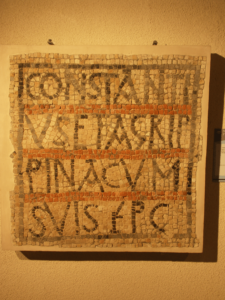
Christian votive inscription on the mosaic floor of the “Basilica del Fondo Tullio alla Beligna” in Aquileia. AE 1975, 410f; Date: Around AD 400. Present Location: Museo Paleocristiano di Monastero, Aquileia; © C. Witschel.
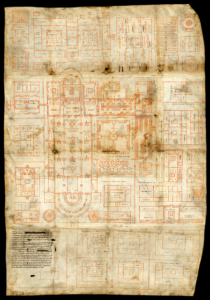
Plano de Saint Gall
(St. Gallen, Stiftsbibliothek, Cod. Sang. 1092), https://www.e-codices.unifr.ch.
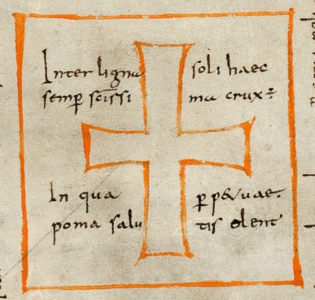
Plano de Saint Gall (St. Gallen, Stiftsbibliothek, Cod. Sang. 1092), cruz del cementerio,
https://www.e-codices.unifr.ch.
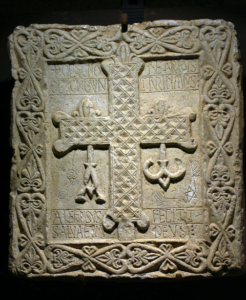
Salas, Iglesia de San Martín, cruz del s. X,
© Museo Prerrománico de San Martín
(Capilla del Palacio de los Valdés Salas).
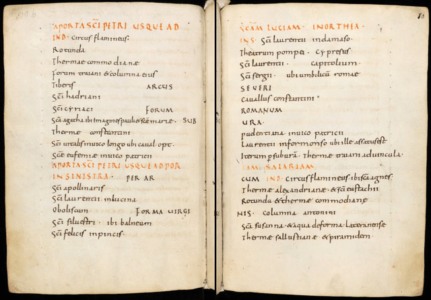
Einsiedeln, Stiftsbibliothek, Codex 326(1076), fols. 79v-80 (Itinerario Einsiedeln), https://www.e-codices.unifr.ch.




